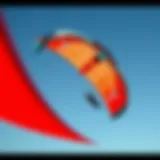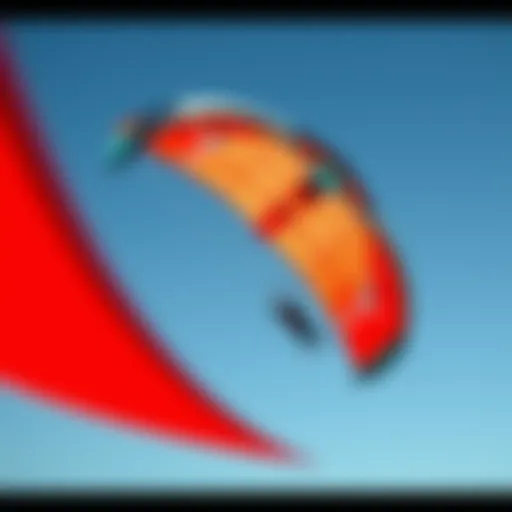Mastering Tides at Jones Beach for Water Sports


Intro
For those who find themselves drawn to the shimmering waters of Jones Beach, understanding the tidal patterns is like having a backstage pass to nature's grand performance. The dance of the tides might appear simple on the surface, but a closer look reveals a complex interplay of factors that can make or break a kiteboarding experience. Here, we take a deep dive into what influences these tides and how you can harness this knowledge to optimize your time on the water.
Kiteboarding, with its mix of wind and wave, requires not only skill but also an acute awareness of the environment. The lunar cycles, the whims of the wind, and the unique geography of the beach all play crucial roles in shaping tidal conditions. For both newcomers eager to ride their first wave and seasoned pros looking to perfect their jumps, being in sync with the tides can mean the difference between a thrilling adventure and a frustrating outing. This comprehensive guide aims to equip you with insights and practical tips, ensuring that you can take full advantage of what Jones Beach has to offer.
By understanding how to interpret tide charts and recognizing optimal wind conditions, you're setting yourself up for success on the water. Plus, we'll provide you with essential gear advice, helping you select equipment that maximizes your performance. So, whether you're an enthusiastic kiteboarder ready to conquer the ocean or a curious soul just dipping your toes in, there's something here for everyone to soak in.
Preface to Tides
When it comes to kiteboarding at Jones Beach, a firm grasp of tidal movements is essential. Tides are not just a backdrop for water activities; they are significant players in the overall beach experience. Understanding how tides operate can enhance both performance and safety for athletes. This knowledge can make the difference between a smooth ride and being caught unaware by changing conditions.
Tides are influenced by a combination of astronomical forces, local geography, and weather elements. The interplay of these factors creates a diverse environment that kiteboarders must navigate wisely. Equipped with insights about tides, enthusiasts can select optimal times for their sessions, ensuring the best possible conditions on the water.
In this segment, we will dissect the foundational elements of tides, as well as their underlying science. We will explore what tides are, dig into the forces that generate them, and consider how those forces work in tandem to create notable tidal patterns. By grasping these concepts, kiteboarders and outdoor enthusiasts alike provide themselves the tools needed to not only improve their skills but to also elevate their overall experience at Jones Beach.
Definition of Tides
Tides refer to the regular rise and fall of sea levels caused by the gravitational forces exerted by the moon and the sun. These fluctuations happen in a cyclical manner, often occurring multiple times each day. Essentially, tides can be understood as the oceans breathing, responding to the celestial mechanics of the universe.
The Science Behind Tides
The mechanics of tides is a complex dance influenced by various astronomical elements. Understanding this science is crucial for those engaging with the water around Jones Beach.
Gravitational Forces
Gravitational forces are the silent giants behind tidal movements. The gravitational pull of celestial bodies exerts its influence quite strongly, with the moon being the major player. This force not only pulls water towards it, creating high tides but also allows areas opposite to the moon to experience a rise of water levels as well.
One of the key characteristics of these forces is their predictability. They follow set patterns, which can be calculated and anticipated. This predictability is immensely beneficial for kiteboarders, as it allows them to plan their activities with reliable expectations of water conditions. The unique feature of gravitational forces is that they vary in intensity with the change in the moon's phases, affecting how tides operate.
Influence of the Moon
The influence of the moon extends beyond mere gravitational pull. As the moon orbits the Earth, its phases—from new moon to full moon—significantly impact tidal ranges. When the moon is new or full, the gravitational pull on the oceans is at its strongest, producing more pronounced high and low tides known as spring tides.
This characteristic of the moon’s influence is both advantageous and disadvantageous. While it can help kiteboarders predict when to anticipate stronger tidal flows, it can also lead to dangerous conditions for the unwary. Recognizing and understanding these cycles can empower kiteboarders to choose the right moments to hit the water or avoid tumultuous conditions.
Sun's Effect on Tidal Patterns
The sun also plays a part in forming tides, albeit a lesser role when compared to the moon. Its gravitational force is significant but more uniform; thus, it contributes to consistency in tidal behavior. During periods when the sun, moon, and Earth align, the effect intensifies, leading to exceptionally high or low tides. These occurrences afford increased opportunities for kiteboarding but also necessitate heightened awareness of potential hazards.
The sun’s effect adds a layer of complexity to understanding and predicting tides at Jones Beach. Sun-related tidal patterns can vary, influenced by seasons, which can offer advantageous conditions for experienced riders looking for specific swells and waves. Being aware of these dynamics is pivotal for those who seek to improve their skills over time.
Jones Beach Geography
The geography of Jones Beach plays a pivotal role in understanding its tides and subsequently, its significance for kiteboarding enthusiasts and water sports alike. By dissecting the location's unique features, we can appreciate how they intertwine with the tidal patterns, ultimately affecting both safety and performance in the water.
Location Overview
Positioned on the southern shore of Long Island, New York, Jones Beach is a stretch of sandy shoreline that draws countless visitors year-round. It spans about six miles, providing ample space for various recreational activities, with kiteboarding being one of the more exhilarating pursuits. The beach's proximity to important urban areas, such as New York City, enhances its accessibility, allowing both locals and tourists to indulge in outdoor fun. This strategic location benefits not only kiteboarders but also fishermen, surfers, and sunbathers who flock to the beach to relish the sun and expansive ocean views.
Topographical Features
Understanding the topographical features of Jones Beach is essential for comprehending the dynamic tidal influences within its waters. There are three main aspects worth focusing on: sand dunes, water depth variations, and coastal currents.
Sand Dunes
The sandy barriers that form the sand dunes at Jones Beach are not just picturesque; they have vital roles in coastal protection and ecosystem health. These dunes act as natural barriers against storm surges and erosion, crucial during harsh weather conditions. Kiteboarders and other water enthusiasts can appreciate the beauty and functionality of these dunes as they navigate the waters; they might even serve as a vantage point for observing tides before hitting the waves. Moreover, the vegetation nestled in these dunes provides habitat for various bird species, enhancing the area's biodiversity. However, individuals must be cautious, as the fragile nature of the sand dunes requires respectful handling to minimize environmental impact.
Water Depth Variations
Water depth variations are significant when it comes to preparing for kiteboarding at Jones Beach. The depth of the water changes continuously with the tides, creating zones suitable for beginners and others more seasoned. Shallow areas close to the shoreline can be ideal for those just starting out, whereas deeper waters might present challenges for more advanced riders looking to push their limits. Understanding these variations can significantly influence the choice of kiteboarding techniques and equipment needed for a successful ride. Additionally, fluctuating depth levels could create unexpected challenges, such as submerged objects or stronger currents—factors that should not be taken lightly by anyone venturing into the surf.
Coastal Currents
The coastal currents at Jones Beach can offer thrilling opportunities for kiteboarders, but they also come with inherent risks. These currents are predominantly influenced by tidal actions, local weather conditions, and even the time of year. Being aware of how these currents flow not only enhances the kiteboarding experience but also promotes safety in the water. Newcomers, for instance, must be particularly cautious, as strong currents can pull them away from the beach more swiftly than expected. Harnessing knowledge of the prevailing currents can help riders map out safer paths and select ideal launching points.


Understanding the geography of Jones Beach is not just about appreciating its beauty—it's about utilizing that knowledge to improve safety and skill in kiteboarding.
Understanding Jones Beach Tidal Patterns
Understanding the tidal patterns at Jones Beach plays a pivotal role in maximizing both safety and performance for water sports enthusiasts, particularly kiteboarders. Given that kiteboarding heavily relies on favorable water conditions, awareness of tidal movements can enhance the experience tremendously. This section highlights the regular tidal cycles prevalent at Jones Beach, delving into the nuances of diurnal and semidiurnal tides and emphasizing their significance in shaping the kiteboarding environment. By grasping these tidal dynamics, enthusiasts can better plan their outings, ensuring they take full advantage of the ideal conditions.
Regular Tidal Cycles
Tides follow a rhythmic pattern influenced by gravitational forces and lunar cycles, presenting a fascinating aspect of marine science. For kiteboarding, understanding these cycles can mark the difference between a challenging session and an exhilarating ride.
Diurnal Tides
Diurnal tides refer to the tidal cycle that experiences one high tide and one low tide each lunar day. This pattern is characterized by its simplicity; for those at Jones Beach, it creates a predictable schedule. Diurnal tides hold appeal because they provide a consistent opportunity for kiteboarders to catch the wind while minimizing the chances of unexpected changes in water levels.
A unique feature of diurnal tides is their relatively stable interval between tidal changes, which typically lasts around 24 hours. Kiteboarders can plan their sessions effectively during this timeframe, making it a popular choice for those seeking a structured approach to their activities.
However, diurnal cycles can also present disadvantages, especially for those who prefer to enjoy extended sessions on the water. With only one high tide per day, enthusiasts must perfect their timing, often leading to crowded conditions during peak tidal moments. Targeting these cycles indeed requires a keen sense of timing and an awareness of other water users.
Semidiurnal Tides
In contrast, semidiurnal tides produce two high tides and two low tides within the same lunar day. This cycle is more common at Jones Beach and offers kiteboarders the flexibility of multiple opportunities to ride the waves. The key characteristic of semidiurnal tides is this duality, which can cater to a wider range of activities and user preferences.
With each high tide often separated by roughly six hours, kiteboarders can enjoy longer hours on the water. The varied height between the two high tides, however, introduces a complexity that can either work in a rider's favor or create challenges, depending on their skill level. For both beginners and advanced riders, understanding this cycle can prove beneficial, facilitating more strategic planning of kiss-off times and locations along the beach.
Yet, the unpredictable nature of semidiurnal tides can make conditions shift unexpectedly. This can lead to altered wave patterns and currents that may pose risks. Consequently, being vigilant about changes and watching for sudden tidal variations becomes essential.
Importance of Tidal Charts
Tidal charts represent essential tools for anyone keen on navigating the waters of Jones Beach. These charts not only provide tidal times and heights but also forewarn users about potential hazards linked to varying tide levels. Analyzing this data, kiteboarders can align their activities with moments of optimal conditions, allowing them to harness the wind and waves to their advantage.
Utilizing tidal charts effectively requires basic knowledge about how to read them. Though some might be intimidated, these charts are typically straightforward, showing high and low tides indicated clearly over specific periods. Here are a few steps to get started:
- Identify your preferred riding schedule: Decide if you prefer morning sessions, afternoon rides, or evening twilight conditions.
- Look up local tidal charts: Many local websites, including NOAA and municipal resources, provide real-time charts and forecasts for Jones Beach.
- Consider your skill level: Beginners should often look for higher tides during earlier parts of the day, while experienced kiteboarders can take chase evening tides for a thrilling experience.
Through careful analysis and understanding of tidal charts, kiteboarders not only enhance their skills but also ensure safer outings. Tidal patterns dictate more than just water levels; they shape the environment for the sport, creating experiences that range from exhilarating to disastrous, depending on one's awareness.
With these insights, kiteboarders can better navigate the ebbs and flows, practicing their passions while remaining safe and savvy on the water.
Influences on Tidal Changes
Understanding the forces that mold tidal movements is crucial for kiteboarders and anyone engaging with the ocean. The dynamic nature of tides is influenced by a variety of factors ranging from celestial mechanics to atmospheric conditions. Knowing these influences not only enhances one’s understanding of the tides but also significantly improves safety and performance during beach activities.
The relationship between lunar phases, weather patterns, and the resulting tidal behavior at Jones Beach is a web of interactions that can provide critical information for kiteboarding enthusiasts. Grasping how these elements interplay can effectively aid riders in choosing optimal times for their adventures.
Lunar Phases and Tides
New Moon Impact
The new moon plays a notable role in tidal patterns, and its impact should not be overlooked. During this phase, the moon, sun, and Earth align in a straight line. This alignment causes higher high tides and lower low tides, known as spring tides. For kiteboarders, this means that at the new moon, there’s typically more water available, allowing for broader areas to ride.
A key element of the new moon phase is that it often coincides with calm winds, making it a favored choice for novice kiteboarders seeking to hone their skills. However, while a new moon brings beneficial larger tidal ranges, this can also lead to stronger currents, presenting a unique challenge for less experienced riders.
- Advantages:
- Disadvantages:
- More water depth for kiteboarding;
- Ideal for practicing techniques;
- Calmer conditions.
- Potential for stronger currents;
- Requires careful monitoring of tidal changes.
Full Moon Influence
Conversely, during the full moon, tidal ranges are also maximized, showcasing another example of spring tides. The alignment of the Earth, moon, and sun at this period results in similar conditions to the new moon, but the atmosphere often carries contrasting wind patterns. Kiteboarders may find more challenges due to gusty conditions associated with full moons, which can kick up waves and make control more tricky.
While the strong tidal movements might seem daunting, they do offer unique opportunities for experienced riders looking to test their limits. The allure of bigger waves can attract adventurous spirits who thrive in these exciting conditions.
- Advantages:
- Disadvantages:
- Bigger waves create thrilling riding;
- Enhanced challenges for skilled riders;
- Exciting atmosphere during outings.


- Potential instability with gusty winds;
- Heightened awareness required.
Weather Patterns
Wind Direction
The direction of the winds has as much impact on the kiteboarding experience as the tides themselves. Winds can either complement or hamper a rider's experience based on their direction relative to the coastline. Onshore winds, blowing from the ocean to the land, generally assist kiteboarders in maintaining lift; while offshore winds can lead to tricky and unpredictable conditions.
Understanding local wind patterns is crucial. For instance, consistent onshore winds during specific seasons can create excellent kitesurfing conditions at Jones Beach. As the wind's character changes with different weather systems, being aware of impending shifts can make or break a session.
- Advantages:
- Disadvantages:
- Onshore winds offer consistent performance;
- Favorable conditions enhance riding enjoyment.
- Offshore winds lead to challenges in control;
- Sudden shifts can surprise unprepared riders.
Barometric Pressure Effects
Lastly, the effects of barometric pressure can’t be overlooked. Changes in air pressure can directly affect wind patterns, consequently altering the tidal conditions as well. A falling barometer often signals stormy weather, which can ramp up wind speeds and stir ocean currents, leading to a more chaotic environment on the water.
It's crucial for kiteboarders to remain vigilant about barometric changes, as they serve as indicators of upcoming weather patterns that will affect tidal behavior. Recognizing a drop in pressure ahead of time can help in making informed decisions about whether to venture out or wait for safer conditions.
- Advantages:
- Disadvantages:
- Awareness of storm systems can lead to safety;
- Monitoring changes allows for better planning.
- Sudden weather changes can pose risks;
- Notifying all riders can be challenging.
Understanding these tidal influences empowers riders to make informed decisions, enhancing both their safety and enjoyment at Jones Beach.
Kiteboarding Implications of Tidal Movements
Tidal movements at Jones Beach hold significant importance for kiteboarding enthusiasts. Understanding the interaction between tides and kiteboarding can dramatically influence the experience of both novices and seasoned riders. The right tidal conditions can enhance performance, safety, and enjoyment in the water, making it essential for participants to be well-informed. Kiteboarding, while thrilling, requires an understanding of the environment, and tides play a pivotal role in this dynamic sport.
Optimal Conditions for Kiteboarding
Tide Levels for Beginners
For beginners, navigating the water safely is priority number one, and understanding tide levels is fundamental. Generally, low tide tends to be a less intimidating experience for newcomers. At this stage, riders can get accustomed to their gear while benefiting from calmer waters and less challenging conditions. Riding during low tide offers a chance for beginners to practice body control and technique without the added pressure of strong currents or turbulent waves.
Moreover, the sandy bottom at Jones Beach provides a forgiving surface for those still mastering their balance. The unique feature of this environment also makes it easier to locate ideal spots based on tides and wind direction. While riding during high tide can be exhilarating, it can also bring sudden challenges that may overwhelm unprepared novices.
Advanced Techniques for Experienced Riders
For those with more experience in kiteboarding, understanding how advanced techniques interplay with tidal movements opens up new avenues for riding. Experienced riders often take advantage of strong tidal currents, capitalizing on these forces to execute jumps and maneuvers that take surfing to new heights. Riding at high tide not only gives access to deeper water—allowing for more daring tricks—but also enables kiteboarders to utilize the momentum created by the tidal flow.
With experience comes the knowledge of how to read water conditions efficiently. Recognizing the unique features of strong currents can significantly enhance performance, pushing riders to new limits. However, it is essential to remember that these conditions require a solid grasp of safety precautions, as they can introduce risks not found at calmer points of the tide.
Safety Considerations
Tidal Currents and Risks
Understanding tidal currents is crucial in kiteboarding. These currents can vary significantly, causing potential risks. For instance, strong outgoing tides can rapidly pull a rider farther from the shore, creating dangerous situations. The key characteristic of tidal currents is their unpredictability, which can change based on weather and lunar cycles. So, being vigilant is essential when riding in areas known for swift currents, especially if you're not yet accustomed to them.
Novice riders need to recognize that while the thrill of the ride is inviting, the power of the tide should not be underestimated. A unique danger here is the possible combination of wind and tidal forces creating unexpected conditions that can pose challenges to safety.
Emergency Protocols
In the fast-paced world of kiteboarding, having a clear plan in the event of an emergency is a game changer. Whether experienced or novice, riders should familiarize themselves with local safety protocols. Emergency protocols often include knowing the closest points to seek shelter, identifying emergency services, and understanding how to signal for help if necessary.
Furthermore, knowing how to operate signaling devices, such as whistles or flags, can help in distress situations. The nature of kiteboarding makes it essential to work as a cohesive community; therefore, sharing information about safety measures among kiteboarders can foster an environment where everyone looks out for each other.
"A stitch in time saves nine." It’s vital to plan ahead and consider the potential risks involved in kiteboarding, particularly relating to tidal movements, so that unexpected scenarios can be handled swiftly and effectively.
The integration of these safety considerations is not merely a formality but a requirement for enjoying the exhilarating experience that kiteboarding offers. By understanding the tidal implications, both success and safety can be maximized on the water.


Accessing Tidal Forecasts
Tidal forecasts serve as essential tools for anyone who enjoys water activities at Jones Beach, especially for kiteboarding enthusiasts. Understanding the ebb and flow of the tides allows kiteboarders to plan their sessions effectively, ensuring they harness the best conditions for optimal performance. In this section, we'll delve into different resources available for accessing tidal forecasts and how to interpret them for your benefit.
Tide Prediction Resources
Online Tide Tables
Online tide tables are a staple for those wanting precise tidal information. Websites such as NOAA (https://tidesandcurrents.noaa.gov) provide comprehensive tables that detail high and low tide times along with tide heights.
The key characteristic of these tables is their accessibility. Anyone with internet access can pull up data in a few clicks, making it a popular choice for busy kiteboarders who need quick insights without sifting through complex data.
An outstanding feature of these tables is their ability to provide long-term forecasts. Users can view not just the upcoming tides but also what to expect weeks ahead. This foresight allows for better planning of kiteboarding trips depending on tidal cycles. However, one disadvantage to consider is the variability in accuracy; certain localized factors can affect tide predictions.
Mobile Applications
Mobile applications for tidal forecasting have jumped in popularity, offering kiteboarders and outdoor enthusiasts a convenient way to access real-time tidal data. Apps like "Tides Planner" or "Tide Charts Near Me" deliver personalized updates based on your geographical location.
These mobile platforms stand out for their user-friendly interfaces, often incorporating visual aids like graphs and charts that help to easily interpret tidal movements. Furthermore, many apps allow users to set alerts for high and low tides, ensuring kiteboarders never miss the optimum conditions.
However, not all mobile applications are created equal. Some may require a subscription or contain advertisements, which could detract from user experience. Additionally, relying solely on a mobile app could lead to issues with connectivity, making it essential for users to cross-reference information with more reliable sources.
Interpreting Forecasts
Understanding how to interpret tidal forecasts is critical. Key indicators to look out for include tide height, timing, and the type of tide, whether diurnal or semidiurnal. Always keep in mind that a tide height that seems ample can vary greatly based on local conditions like wind and weather patterns.
"Always have a reliable source for tidal information, it can make or break your kiteboarding experience!"
By becoming familiar with these forecasts, kiteboarders can better judge when to head out for a session, what gear to prepare, and how to stay safe in shifting water conditions. Whether you prefer online sources or handy mobile applications, ensuring you have access to the latest forecasts could potentially enhance your experiences on the water.
Community Insights and Experiences
The significance of community insights and experiences cannot be overstated in the world of kiteboarding at Jones Beach. This section aims to weave together the threads of personal testimonies and shared knowledge within the kiteboarding community, shedding light on aspects that guide both newcomers and seasoned veterans alike.
By tapping into the collective wisdom of fellow kiteboarders, enthusiasts can glean valuable information that goes beyond mere tide charts and technical advice. These personal accounts emphasize real-world applications of tidal data and the intricacies of navigating fluctuations in conditions. More than just a collection of stories, these insights serve as a pivotal resource for understanding how environmental variables can alter one’s kiteboarding experience.
"The tides can turn quickly, and a simple shift can mean the difference between a successful day on the water and an unwanted struggle."
Local experiences enrich the fabric of our understanding, illustrating how factors like wind patterns, barometric pressure changes, and, of course, tides influence the water’s temperament. As kiteboarders share their journeys, they hint at hidden gems, such as lesser-known safety protocols or optimal spots for launch and landing. This exchange of knowledge fosters a stronger community and enhances everyone's water sports experiences.
Kiteboarder Testimonials
Kiteboarder testimonials bring an authentic voice to the narrative, allowing readers to resonate with personal adventures and lessons learned on Jones Beach. Each testimonial is a chapter in the community's evolving story, a firsthand account that highlights not only triumphs but also challenges faced during sessions affected by tidal changes.
Some examples include riders recounting those perfect afternoons where they rode the tides just right, while others might share cautionary tales about misjudging the water current’s pull. Storytelling is an integral aspect of this exchange, so look to popular community platforms like Reddit or dedicated Facebook groups to find these nuggets of information. Testimonials may cover:
- Specific tidal conditions that enhanced their performance
- Incidents involving unexpected changes
- Advice on timing your sessions based on tide cycles
These stories not only aim to inform but also to entertain, fostering camaraderie among kiteboarders who can relate to similar experiences. The insights derived from these accounts become touchstones for newer riders trying to make sense of their journeys.
Sharing Best Practices
The sharing of best practices is a hallmark of any supportive community, and kiteboarding enthusiasts are no exception. As riders hone their skills, they often discover methods that maximize enjoyment while minimizing risk. Best practices at Jones Beach take into account not just the physical sensations of riding but the environmental variables that can affect outcomes.
For instance, adapted techniques for navigating specific tidal conditions or tips for gear maintenance based on exposure to saltwater are common themes. Here are some best practices gleaned from community experiences:
- Timing the session: Align your ride times with tide cycles for optimal conditions. Many local riders emphasize low tide for certain techniques, like jumps.
- Gear preparation: Regularly check kites and lines for wear, especially after heavy usage in tidal movements. Saltwater can work wonders, but it isn't kind to equipment.
- Safety first: Always assess tidal currents before launching. Knowledge is crucial; take advice from seasoned riders about navigating tricky water flows.
Through the active sharing of information, community members forge stronger connections and ensure that everyone can enjoy the full spectrum of kiteboarding potential at Jones Beach. By surrounding yourself with this wealth of knowledge, you contribute to and benefit from a culture that prioritizes safety, fun, and above all, continuous learning in this exhilarating sport.
The End
Understanding the tidal movements at Jones Beach is more than just a passing interest for kiteboarders and water sports enthusiasts; it's akin to possessing a roadmap to potential success on the waves. With every shift in tide, there lies an opportunity to enhance one's experience—be it through achieving optimal conditions for exhilarating rides or ensuring safety during adventures on the water.
Recap of Key Takeaways
- Tidal Patterns and Timing: Familiarity with the local tidal schedules can significantly impact performance during kiteboarding sessions. Recognizing whether the tides are rising or falling—and at what times—can dictate when you hit the water for those sweet, rideable conditions.
- Lunar and Weather Influences: Keeping an eye on lunar phases and weather patterns is crucial. For instance, full moons often mean higher tides which could either mean better conditions or risks associated with strong tidal currents. Likewise, understanding wind effects can turn a mediocre day into an outstanding one.
- Resourceful Kiteboarding Practices: Community experiences have shown the value of learning from others. Local testimonials provide insights into various techniques and approaches that cater to different skill levels, ensuring that every ride is both enjoyable and safe.
Final Thoughts on Tides and Kiteboarding
In this ever-changing dance between the moon's gravitational pull and the whims of weather, kiteboarders at Jones Beach find themselves in a unique position. The tides, as intricate as they are, present both challenges and rewards. Recognizing when to take advantage of high or low tide is not merely a skill but also an art form. Being in tune with nature’s rhythm can lead to not just a routine day out but rather an unforgettable experience on the water.
In summary, knowledge equips you. Therefore, tapping into the resources discussed in this guide—from understanding tidal forecasts to listening to community insights—ensures that your time spent at Jones Beach is maximally rewarding. So, next time you grab your gear, take a moment to reflect: what position am I in relation to the tides? The answer might just turn an ordinary outing into an extraordinary adventure.















